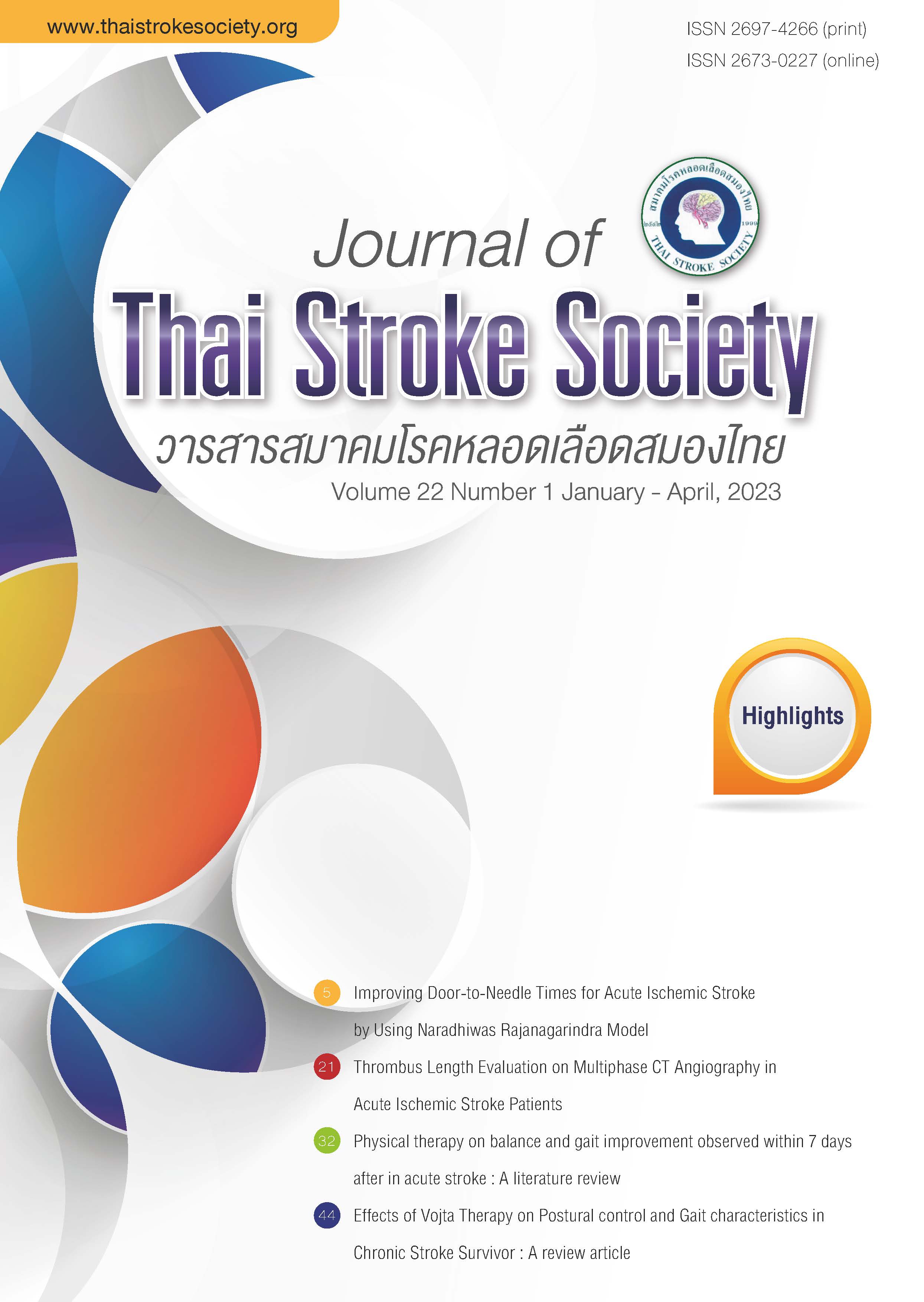Effects of Vojta Therapy on Postural control and Gait characteristics in Chronic Stroke Survivor: A review article
Keywords:
Vojta therapy, hemorrhagic stroke, Postural control, GaitAbstract
Vojta therapy is a physical therapy technique that relies on the principle of reflex locomotion stimulation of the neurophysiological system. This technique induces reflex movement by the therapist to apply force to a specific area (specific zone). Recently, Vojta therapy has been shown to stimulate brain activity in the supplement motor areas, premotor areas, superior parietal cortex, and posterior cingulate cortex. It is believed that Vojta therapy could promote posture, balance, and walking in stroke survivors. Therefore, this review article aimed to comply with the study of Vojta therapy in chronic stroke survivors, which is a specific technique that must be practiced and has contraindications and cautions in this group of patients. However, few studies were found in the last two decades. This technique should be applied as a treatment and in clinical applications in the future.
References
Langhorne Peter, Bernhardt Julie and Kwakkel Gert. Stroke rehabilitation. The lancet 2011;377(9778):1693-1702.
Amin Louis. Rehabilitation plan and process in patient after stroke [Bachelor]. Brno: Masaryk University; 2020.
J. Winstein Carolee, Stein Joel, Arena Ross, Bates Barbara, R. Cheney Leora.et al. Guideline for adult stroke rehabilitation and recovery: A Guideline for healthcare processionals from the American heart association/American stroke association. ResearchGate 2016;47:e1-e72. DOI: 10.11161/STR.0000000000000098.
E. Titianova. Hemiparetic gait in stroke neurorehabilitation. ESNCH 2014;10(2):123-130.
Wang Yiji et al. Gait characteristic of post-stroke hemiparetic different walking speeds. Int J Rehabil Res. 2020;43(1):69-75.
Zafeiriou D I. Primitive reflexes and postural reactions in the neurodevelopmental examination. Pediatr Neurol 2004;3:1-8.
Vojta therapy in adulthood information for adults with movement impairments. International Vojta society 2015;3:1-15.
H. Bauer, G. Appaji and D. Mundt. Vojta neurophysiologic therapy. Indian J Pediatr 1992;59:37-51.
รศ. พิมพ์อำไพ เวนเซล. Vojta principle muscle action in reflex movement and motor ontogenesis. Vojta Therapy for adults with mobility difficulties 2nd batch Course A. 31/07/2017-11/08/2017; สถาบันสิรินธร เพื่อการฟื้นฟูสมรรถภาพทางการแพทย์แห่งชาติ. นนทบุรี: มูลนิธิศูนย์สิรินธรเพื่อการฟื้นฟูสมรรถภาพทางการแพทย์แห่งชาติ; 2017. หน้า1-53.
Carratala-Tejada M. et al. Reflex locomotion therapy for balance, gait and fatigue rehabilitation in subjects with multiple sclerosis. J Clin Med 2022;11(567):1-12.
Sanz-Esteban I, et al. Cortical activity during sensorial tractile stimulation in healthy adults through Vojta therapy. A randomized pilot-controlled trial. J NeuroEngineering Rehabil 2021; 18(13):1-13.
Akay T and J Murry A. Relative contribution of proprioceptive and vestibular sensory systems to locomotion: opportunities for discovery in the age of molecular science. Int J Mol Sci 2021; 22(1467):1-18.
Martinek M, Panel D, Novakova T and Pavlu D. Analysis of intracerebral activity during reflex locomotion stimulation according to Vojta’s principle. Appl Sci 2022; 12(14):1-9.
Ha SY and Sung YH. Changes of neural pathway after Vojta approach in a child with Developmental delay. Children 2021; 8(918):1-7.
Lim H and Kim T. Effects of Vojta therapy in gait of children with spastic diplegia. J Phys Ther Sci 2013;25:1605-1608.
Sung YH and Ha SY. The Vojta approach changes thickness of abdominal muscle and gait in children with spastic cerebral palsy: A randomized controlled trial, pilot study. Technol Health Care 2019;13(28):1-9.
Juan-Manuel Belda-Lois, Silvia Mena-del Horno, Ignacio Bermejo-Bosch, Juan C Moreno, Jose L Pons, Dario Farina et al. Rehabilitation of gait after stroke: a review towards a top-down approach. J NeuroEng Rehabil 2011;8(66):1-19.
Lopez P-L et al. The implementation of a reflex locomotion program according to Vojta produces short-term automatic postural control changes in patients with multiple sclerosis. J Bodyw Mov Ther 2021;26:401-405.
Epple C, Maurer-Burkhard B, Lichti MC and Steiner T. Vojta therapy in patient with acute stroke: A new approach in stroke rehabilitation. Phys Med Rehabil Int 2018;5(1):1-5.
Epple C, Maurer-Burhard B, Lichti MC and Steiner T. Vojta therapy improve postural control in very early stroke rehabilitation: a randomized controlled pilot trial. Neurol Res Pract 2020; 2(23):1-11.
Tayati W, Chompunuch N and Wongphaet P. Effect of Vojta therapy on balance and walking of community dwelling chronic stroke patients. ASEAN J Rehabil Med 2020;30(1):21-25.
Rogers M and Martinez K. Recovery and rehabilitation of standing balance after stroke. In: Stein J, Harvey RL, Macko RF, Winstein CJ, Zorowitz RD, editors. Stroke recovery and rehabilitation. 1st ed. New York: Demos medical publishing; 2009. P.343-374.
Hok P and Hlustik P. Modulation of the human sensorimotor system by afferent somatosensory input: evidence from experimental pressure stimulation and physiotherapy. Biomed Pap Med Fac Univ Palacky Olomouc Czech Repub 2020;164:1-9.
กนกวรรณ ติลกสกุลชัย. สรีรวิทยาระบบประสาทส่วนกลาง. ใน: สุพรพิมพ์ เจียสกุล, สุพัตรา โล่ห์สิริวัฒน์ และวัฒนา วัฒนาภา. สรีรวิทยา 3. พิมพ์ครั้งที่ 1. กรุงเทพฯ: เรือนแก้วการพิมพ์; 2544. หน้า 890-1063.
Ha SY and Sung YH. Effects of Vojta method on trunk stability in healthy individuals. JER 2016;12(6):542-547.
Zmf-asia.org [homepage on the Internet]. Thailand: Zy movement foundation Thailand. [update 2021; cited 2022 Mar 26]. Available from: https://www.zmf-asia.org/17518580/vojta-therapy-กดจุดวอยต้า
Downloads
Published
How to Cite
Issue
Section
License
Copyright (c) 2023 Journal of Thai Stroke Society

This work is licensed under a Creative Commons Attribution-NonCommercial-NoDerivatives 4.0 International License.
ข้อความภายในบทความที่ตีพิมพ์ในวารสารสมาคมโรคหลอดเลือดสมองไทยเล่มนี้ ตลอดจนความรับผิดชอบด้านเนื้อหาและการตรวจร่างบทความเป็นของผู้นิพนธ์ ไม่เกี่ยวข้องกับกองบรรณาธิการแต่อย่างใด การนำเนื้อหา ข้อความหรือข้อคิดเห็นของบทความไปเผยแพร่ ต้องได้รับอนุญาตจากกองบรรณาธิการอย่างเป็นลายลักษณ์อักษร ผลงานที่ได้รับการตีพิมพ์ในวารสารเล่มนี้ถือเป็นลิขสิทธิ์ของวารสาร





